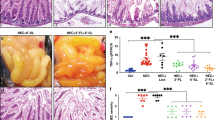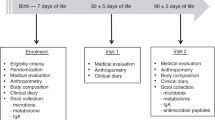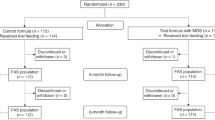Abstract
Objective:
To test whether breastfeeding's protection against anorectic responses to infection is mediated by n−3 fatty acids’ attenuation of interleukin (IL)-1β and tumor necrosis factor (TNF)α.
Design:
Experimental and observational studies.
Setting:
A hospital-based study was conducted.
Subjects:
Five groups of infants were followed; three in the experimental and two in the observational study.
Methods:
Breast-fed- (BF-1), DHA-supplemented formula- (SFF-1), and non-DHA-supplemented formula-fed (FF-1) infants were studied before and after immunization against diphtheria, tetanus, pertussis and haemophilus influenzae type b. Pre- and post-immunization energy intakes (EI) and serum IL-1β and TNFα were measured. The two other groups, breast-fed (BF-2) and formula-fed (FF-2) infants with pneumonia were followed throughout hospitalization. EI, IL-1β and TNFα were measured at admission and discharge. Baseline erythrocyte fatty acid contents were determined.
Results:
Both cytokines increased following immunization in all feeding groups. Post-immunization reductions in EI of SFF-1 infants (−11.8±5%, CI95=−23.3, 1.4%, P=0.07) were intermediate to those observed in BF-1 (−5.2±4.2%, CI95=−15.2, 5.9%, P=0.27) and FF-1 infants (−18±4.4%, CI95=−29%, −5.4%, P=0.02). In the observational study, TNFα (17.2±8.3 vs 3.4±3.0 ng/l, P=0.001) and decreases in EI (−31±43 vs −15±31%, CI95=−34%, 0.001%, P=0.056) were greater in FF-2 than in BF-2 infants at admission. Breastfeeding duration was associated positively with docosahexaenoic acid (DHA) erythrocyte contents, and negatively with admission TNFα. Decreases in EIs were associated with IL-1β and TNFα concentrations.
Conclusion:
Reductions in EI following immunologic or infectious stimuli were associated with increases in IL-1β and TNFα. Those reductions were attenuated by breastfeeding, and mediated in part by tissue DHA.
Sponsorship:
This research was supported by grants from the Nestlé Foundation and the CONACYT Mexico. Nutricia Kasdorf (Buenos Aires, Argentina) provided supplemented and unsupplemented formulas.
This is a preview of subscription content, access via your institution
Access options
Subscribe to this journal
Receive 12 print issues and online access
$259.00 per year
only $21.58 per issue
Buy this article
- Purchase on Springer Link
- Instant access to full article PDF
Prices may be subject to local taxes which are calculated during checkout



Similar content being viewed by others
References
Blok WL, Katan MB, Meer JWM (1996). Modulation of inflammation and cytokine production by dietary (n−3) fatty acids. J Nutr 126, 1515–1533.
Brown KH, Stallings RY, Creed de Kanashiro H, Lopez de Romana G, Black RE (1990). Effects of common illnesses on infant's energy intakes from breast milk and other foods during longitudinal community-based studies in Huascar (Lima), Peru. Am J Clin Nutr 52, 1005–1013.
Calder PC (1997). N-3 polyunsaturated fatty acids and cytokine production in health and disease. Ann Nutr Metab 41, 203–234.
Caughey GE, Mantzioris E, Gibson RA, Cleland RG, James MJ (1996). The effect on human tumor necrosis factor α and interleukin-1β production of diets enriched in n−3 fatty acids from vegetable oil or fish oil. Am J Clin Nut 63, 116–122.
Chiesa C, Pellegrini G, Panero A, Osborne JF, Signore F, Assumma M, Pacifico L (2003). C-reactive protein, interleukin-6, and procalcitonin in the immediate postnatal period: Influence of illness severity, risk status, antenatal and perinatal complications, and infection. Clin Chem 49, 60–68.
Endres S, Ghorbani R, Kelley VE, Georgilis K, Lonnemann G, van der Meer JW, Cannon JG, Rogers TS, Klempner MS et al. (1989). The effect of dietary supplementation with n−3 polyunsaturated fatty acids on the synthesis of interleukin-1 and tumor necrosis factor by mononuclear cells. N Engl J Med 320, 265–271.
Goldman AS, Garza C, Nichols BL, Goldblum RM (1982). Immunologic factors in human milk during the first year of lactation. J Pediatr 100, 563–567.
Granot E, Golan D, Berry EM (2000). Breast-feed and formula-fed infants do not differ in immunocompetent cell cytokine production despite differences in cell membrane fatty acid composition. Am J Clin Nutr 72, 1202–1205.
Hoyle BY, Yunus M, Chen LC (1980). Breast-feeding and food intake among children with acute diarrheal disease. Am J Clin Nutr 33, 2365–2371.
Jensen RG (1995). Handbook of Milk Composition. pp 439–443. San Diego: Academic Press.
Klasing KC (1988). Nutritional aspects of leukocytic cytokines. J Nutr 118, 1436–1446.
López-Alarcón M, Garza C, Habicht JP, Martínez L, Pegueros V, Villalpando S (2002). Breastfeeding attenuates reductions in energy intake induced by a mild immunologic stimulus represented by DPTH immunization: Possible roles of interleukin-1β, tumor necrosis factor-α and leptin. J Nutr 132, 1293–1298.
López-Alarcón M, Bernabe-Garcia M, del Prado M, Rivera D, Ruiz G, Maldonado J et al. (2006). Docosahexaenoic acid administered in the acute phase of infection protects nutritional status of septic neonates. Nutrition 7, 731–737.
McCarthy DO, Kluger MJ, Vander AJ (1985). Suppression of food intake during infection: is interleukin-1 involved? Am J Clin Nutr 42, 1179–1182.
Michie HR, Sherman ML, Spriggs DL, Rounds J, Christie M, Wilmore DW (1989). Chronic TNF infusion causes anorexia but not accelerated nitrogen loss. Ann Surg 209, 19–24.
Sellmayer A, Koletzko B (1999). Long-chain polyunsaturated fatty acids and eicosanoids in infants-physiological and pathophysiological aspects and open questions. Lipids 34, 199–205.
Serhan CN (2006). Novel chemical mediators in the resolution of inflammation: resolvins and protectins. Anesthesiol Clin 24, 341–364.
Socher SH, Friedman A, Martinez D (1988). Recombinant tumor necrosis factor induces acute reductions in food intake and body weight in mice. J Exp Med 167, 1957–1962.
Author information
Authors and Affiliations
Corresponding author
Additional information
Contributors: MLA conceived the original idea together with CG, performed the study, analyzed the data, and wrote the first draft; CG conceived and refined the original idea, advised on study design and data analysis and critically appraised the paper; MDP supervised the project especially on the lab determination and analyses of fatty acids; LB and PAGZ participated in data collection, clinical measurements and laboratory determinations.
Rights and permissions
About this article
Cite this article
López-Alarcón, M., Garza, C., del Prado, M. et al. Breastfeeding's protection against illness-induced anorexia is mediated partially by docosahexaenoic acid. Eur J Clin Nutr 62, 32–38 (2008). https://doi.org/10.1038/sj.ejcn.1602686
Received:
Revised:
Accepted:
Published:
Issue Date:
DOI: https://doi.org/10.1038/sj.ejcn.1602686



